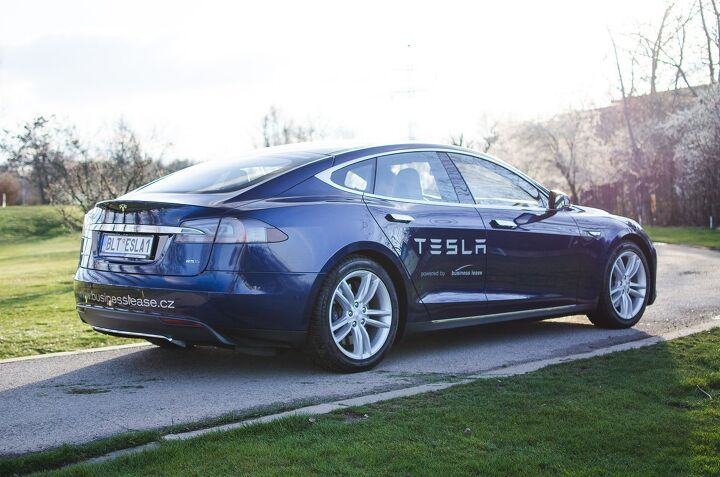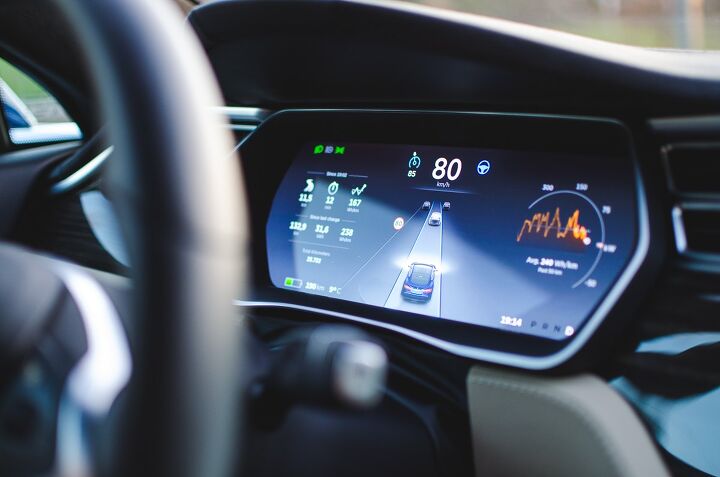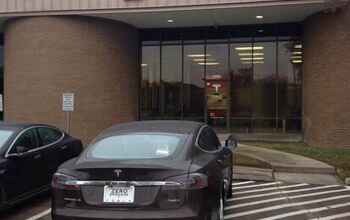Tesla Model S 85D European Review: The Future or the Killer?
The Tesla Model S is neither new nor surprising anymore. When the electric sedan entered the market in 2012, it shattered perceptions of electric cars and proved electric motoring viable.
Since then, Tesla has established itself as the go-to brand for geeks and early adopters. We’ve driven the Tesla Model S before, so there’s no need to talk about its most obvious features. But recent events make this a great time to talk about its second-most-important feature: Autopilot.
Is Tesla’s autonomous system any good? Can it be dangerous? How far is it from being truly autonomous? And, besides that, how did the Model S improve over the last few years?
I must admit, of all cars I’ve driven this year, I was most excited about getting behind the wheel of the Model S. I drove one of the early P85 models when they came out, but only briefly and without an opportunity to exploit its real-world usability or range. This time, I had three days with the car. With lots of people wanting to catch a ride in the Model S (the Tesla is still quite a rare sight in Czechia), it was a perfect opportunity to see how the electric car works day-to-day, and in rather challenging conditions.
Why were the conditions challenging? Three things.
First, I had to pick up the car in Prague, drive it to my hometown, then back to Prague the next day to allow a local celebrity traveller, Dan Přibáň, to review it. After that, I had to drive to Brno, the country’s second largest city, to our version of Cars and Coffee. In all, I planned to cover almost 600 miles over three days.
That alone wouldn’t be necessarily difficult if I lived in a house and not an apartment building. But lacking friends with an electrical outlet powerful enough (or close enough to a parking space) to charge a Tesla, I was without any option for overnight charging.
Which brings me to the last problem: the first Supercharger in our country was finished some time after this review, so I had to rely on slower CHAdeMO and Mennekes Type 2 public chargers designed mostly for smaller batteries, like those found in the Nissan Leaf.
Driving and Range
When I arrived to pick the car up, I was disappointed that it was only a 85D, and not the high-performance P85D I’d originally hoped for. After being amazed by the acceleration of the normal P85, I really wanted to try the faster Q-car. But even so, this car is quick — much quicker than the 4.2-second sprint to 60 miles per hour would suggest. It was enough to make most passengers giggle after one or two full throttle runs, and I now fully believe the P85D’s Ludicrous Mode can reverse a passenger’s digestion.
Even more important than showing off with acceleration is the Model S’s ability to be eerily quick in traffic. The way the Model S accelerates into gaps in traffic, from intersections, and out of highway merge lanes is not only fascinating, but makes for a much more relaxed driving experience. You’re not stressed about having to catch up with other cars. Instead, you just adjust your speed as needed. This flexibility is so addictive that, after a while, you start thinking of gasoline motors as something on par with the steam engine.
I couldn’t test range last time as I simply didn’t have enough time with the Model S to drain the battery. This time, I had plenty of opportunity to get acquainted with public charging and range anxiety — and I could finally find out how far the Tesla could make it on a charge, whether on an economy run or a spirited sprint. This was also one of the first things people asked: “I know it is supposed to go 270 miles on a charge, but how far does it really go?” With European fuel economy tests being totally disconnected from reality ( which I wrote about some time ago), this is of great concern to Europeans.
At first, I kept on the safe side of the battery’s charge capacity. I did a few runs around Prague to demonstrate the Tesla’s capabilities to friends and colleagues. In doing so, I drained the battery significantly and didn’t have enough time to fully recharge, so I went home (an 80 mile drive) slowly and carefully. The same was true for the run back to Prague the next day, and home again after that. I recharged the batteries whenever I had an opportunity, but I was still chronically low on battery due to a lack of Superchargers in the country. CHAdeMO chargers take an hour and a half to fully charge the 85D, but they are quite rare. Instead, I often relied on the slow Mennekes chargers, which require several hours. This meant that during the three test days, I only had a full battery twice.
Even so, I learned that I could dart around the country with little difficulty, and discovered the stated range of 270 miles to be surprisingly realistic as long as you drive with a tempered foot. But I already knew that, though not first hand.
But what happens when you drive with no regard to economy whatsoever? When I had a 80 or 90 mile run to do, with battery almost full and a quick charger in my destination, I decided to rush it, doing 20-30 miles per hour over the limit. I was quicker with the Golf R Wagon a few weeks before, but the Tesla run was still about as quick as anyone could want to drive on a public road for an extended period of time. Still, the Tesla’s power consumption was equal to the range of some 200 miles, making it quite practical even for “spirited” drivers.
Can It Drive Itself?
This drive was the only one I completed fully in manual mode. Of the rest, I drove about 95 percent of the time with AutoSteer on. Well, maybe “rode” is the right term instead of “drove.” The Autopilot feature was what I was most looking forward to try, and it didn’t disappoint. Sort of.
The moment you first activate AutoSteer and slowly, cautiously move your hands off the steering wheel is one part fascinating, one part terrifying. The first stage is cautious disbelief. You see the car steering itself and monitor what the car “sees” on the dashboard display, but you don’t really trust it. For a few dozen miles, you ride with your hands just off the steering wheel, ready to intervene if anything happens.
As you watch the car cope with traffic and obstacles, you slowly gain more and more confidence in the computer, and eventually relax with your hands on your lap. No matter how much you read about autonomous cars, it’s all on par with astrophysics or Star Trek until you experience one. Riding in a Tesla with Autopilot is the first time you’ll truly believe that autonomous driving may, one day, be possible.
But no matter what Elon Musk says, Autopilot is still beta software in the truest sense. Now and then, the system will remind you to keep your hands on the steering wheel, forcing you to touch the wheel for a while for it to sense your input. And while the AutoSteer works well on highways and large city arteries, it doesn’t seem very confident on smaller roads, or in coping with the unexpected.
Of the 500 or 600 miles with the Tesla, I probably did 350 of them on Autopilot. Most of my highway runs were spent just watching the car drive itself, chatting with the passengers and listening to music. I could even take my eyes from the road for a while and watch the landscape around me. I saw things I had never noticed in the years I drove those roads. And, what was most interesting, I still felt like I was in control of the car. Even without touching it, the steering wheel in front of me and the knowledge that I could grab it at any time gave me the feeling of “driving” the car without actually doing so. In those three days, the Model S sold me on the idea of self-driving cars. Letting it drive you is more akin to being the captain of a ship and watching your underlings perform your orders than riding shotgun.
But — and it’s a very large BUT — Autopilot is nowhere near ready yet. I felt safe letting it drive itself on a four-lane highway, with a long straight in front of me, steady traffic and no road construction. Even at night, I knew it would stay in its lane and cope with surrounding traffic. But anytime anything unexpected happened, I grabbed the wheel and took control — and for a good reason. A few times, I tried to let Tesla do its thing to see how close to accident it will get before intervening. The results weren’t very convincing.
While driving on a perfect highway was no problem, the Model S would follow the wrong set of road lines or overlook some cones in roadwork areas. It also couldn’t be trusted around cyclists (it would have run over at least one, were I not watching over it), and some traffic obstacles were pretty difficult for it to understand.
In short, letting it drive while you are cognizant of what’s going on around you is perfectly safe, and much less tiring than actually driving. I can imagine driving a whole day non-stop (however impossible that may be with EV) without getting tired. But sleeping or watching movie while leaving all driving responsibilities to the car? Never. Not even on a nice highway.
While driving the Tesla sold me on the idea of self-driving car, it certainly didn’t persuade me that the fully autonomous one is anywhere near. A car that can safely navigate a highway is possible in a few years. But autonomous driving in cities, towns and villages? On roads without clear markings? In bad weather? With all my admiration for Mr. Musk, there’s a pretty long way to go.
Between the electric drivetrain and the Autopilot, this Model S represents the future. A time will come when manual gasoline cars will look like steam ships. It may be in 10 years. It may be 20. It may be five, if the technology moves much faster than expected. But it still is the future, not the present.
The Model S, though, is a great car now. There may be times when its range can be limiting, and its Autopilot still feels very “beta,” but for most of the time, it’s the best car on sale right now that does what it does.
[Images: © 2016 David Marek/The Truth About Cars]
More by Vojta Dobe
Latest Car Reviews
Read moreLatest Product Reviews
Read moreRecent Comments
- Steve Jacobs I've got a bright Red Kia EV6. Easy to find in a parking lot.
- MKizzy Gently used EV6's under $30K aren't hard to find and have the range and style to almost intrigue me into taking the EV plunge. However, I'll wait for a mid-sized non-luxury EV sedan or wagon which is not a tablet housing a car (Model 3) or sacrifices too much usable space for the sake of style (Ioniq 6) before I go electric. I'm not holding my breath.
- Arthur Dailey Am currently comparing both vehicles. Some issues not addressed in the article 1) the wait times for most RAV4's are currently considerably longer, 2) RAV4's are among the most stolen vehicles in my area (the GTA), 3) Mazda has a superior warranty. Manufacturing locations are perhaps a toss up. For the majority of these vehicles sold in the Canadian market from what I can ascertain, CX-5's are manufactured in Japan, and RAV4's in Alliston Ontario. One area where I will disagree with Matt is in the upholstery. I far prefer cloth to leather. With grandchildren and a dog, there is far more chance that the leather will be cut or scratched. And leather, particularly in black is too hot in the summer and very cold when you first sit on it during a Canadian winter. Cloth is the winner in that competition, but still an inferior choice to rich 1970's style velour upholstery.
- Eliyahu I've had my 2018 CX-5 FWD top trim for about 18 months. It is fun to drive and a nice design. Mazda really did a great job of making the most out of the platform when they did the design refresh. The driver's seat, however, is overly firm and perhaps a tad too small. I have also come to appreciate the open feeling of the Forester compared to the well-organized but more closed in cockpit of the CX-5. A minor quibble would be the smallish gas tank. Overall, a very nice design.
- Redapple2 CX5. Rented one 2 yr ago. ~2000miles. Issues. 1 Thumbwheel controller not good. 2. Sweeping curve on the interstate passing a car, the automatic braking picked up a car in the lane over. Beeps and slight braking. Not drop anchor mode, but still head scratching. But it looks so dam good. Wonderful still after many years. CX5 all the way!!!



















































Comments
Join the conversation
That's too bad about the Supercharger. As soon as you mentioned it, I thought "didn't they just install one between Prague and Brno?", but then you said your review took place before that installation. Sipping from a Level 2 Chademo charger would add unnecessary range anxiety. You tested my favorite color combination, and it's refreshing to see a review of a Tesla that doesn't feature ludicrous mode. Although I've said I never want Autopilot, I wonder if I'd get used to it as you did. Also, I see you've adopted the new "Czechia" term, but I thought locals hated it. What gives?
I'm surprised there's no thread on Tesla's Q2 $286M loss and Musk admitting that the production rate has been an utter disaster.